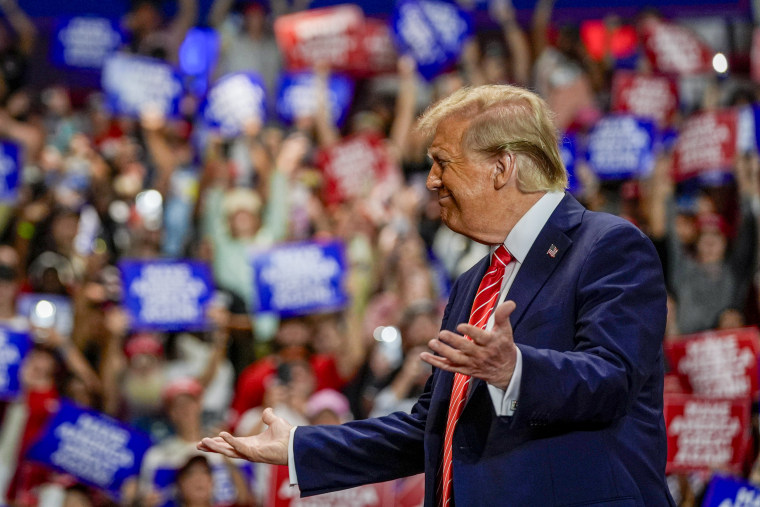With former President Donald Trump floating higher and more far-reaching tariffs if he’s elected to a new term, small businesses that sell everything from bikes to beer are nervous about another cost hike that they’d have to pass on to customers.
Chris Smith, the co-founder of Virginia Beer Co. in Williamsburg, Virginia, remembers when he first spotted a 5.5% surcharge on a statement from one of his suppliers, a U.S.-based seller of tap handles manufactured in China. The fee turned up in September 2019, after Trump placed 25% tariffs on steel, and hasn’t gone away since.
Smith spends anywhere from $15,000 to $20,000 each year on tap handles emblazoned with the names of his beers — with about $1,000 of that covering the cost of the tariff. He sells them to distributors that get them placed in bars and restaurants that sell his draft beers, increasing the price to cover the tariff surcharges.
“The beer business specifically is a low-margin, high-volume business,” he said. “We don’t have the volumes that a major player has just by virtue of our size.”
Any increase in our input costs absolutely affects our profitability.
Chris Smith, co-founder of Virginia Beer Co.
By contrast, Constellation Brands, which imports Corona and Modelo from Mexico and recently reported about $3 billion in quarterly revenue, has waved off concerns about further tariffs, saying the company thrived under Trump. But smaller operators have less wiggle room, Smith said: “Any increase in our input costs absolutely affects our profitability.”
Small-business owners have already been facing tariffs on billions of dollars of goods, most of them from China, implemented by Trump in 2018. The Biden administration, which largely kept them in place, unveiled new levies of its own in May — though experts say they’re mostly symbolic moves in a green-tech standoff. So far, the tariffs in force under both White Houses have cost Americans $79 billion, the nonpartisan Tax Foundation estimated this summer.
Consumers who’ve been finding their footing after a historic run-up in inflation — which had little to do with federal trade policy — aren’t likely to have seen tariffs dent their wallets dramatically beyond a few targeted products in recent years, like washing machines or solar panels.
But “if you were a business owner and your supply of something from China was directly impacted, then you definitely noticed,” said Erica York, a senior economist at the Tax Foundation.
Many of the large U.S. companies facing tariffs have either rejiggered their supply chains to avoid them or else eaten the cost, wholly or in part. Bigger firms tend to have more flexibility to source new suppliers and more leverage to negotiate terms, experts say.

“For the small businesses, unfortunately they’re not in a position where they can absorb those additional costs,” said Jonathan Gold, vice president of supply chain and customs policy at the National Retail Federation, a major trade group.
The nation’s roughly 33 million small businesses employ nearly half the nation’s workers and generate more than 43% of the gross domestic product, the U.S. Chamber of Commerce estimates. And it’s small and medium-sized firms that disproportionately bear the burden of tariffs, Gold said; in many cases, “they’ve got to go ahead and pass those costs directly on to the consumer.”
That’s what Ryan Zagata, the founder of Brooklyn Bicycle Co. in New York City, had to do. He estimated that 95% of the over 100 parts needed to build a bike are made overseas.
“Whether we like it or not, Asia is the bike manufacturing hub of the world,” said Zagata, who raised prices by between 18% and 22% after the Trump tariffs took hold. He expects he’d have to hike further if a re-elected Trump were to impose his promised 20% blanket levy on all imports.
In addition to that tariff, the GOP nominee also calls for a duty of at least 60% on goods from China, a 100% tariff on countries that ditch the dollar as a common trade currency, and a 2,000% tariff on vehicles built in Mexico.
The tariffs that small and medium-sized businesses have shouldered under the current and prior administrations are “pretty extreme” by historical standards, said Felix Tintelnot, an international trade economist at Duke University. “In the last 75 years, we didn’t have tariff levels anywhere near as high.”
Taken together, these proposed duties would be “magnitudes larger” than those Trump implemented years earlier, said York, and could be “massively disruptive to the way businesses have planned their supply chains.” She expects more severe, long-lasting tariffs would have a “chilling effect” on investment and could encourage retaliation from other countries. Even Germany, a key U.S. ally and trade partner, has warned of that outcome.
Economists broadly oppose Trump’s tariff plans, saying their main outcome would be higher costs for consumers. Last week, a joint letter by nearly two dozen Nobel-winning economists warned that Trump’s proposed “high tariffs even on goods from our friends and allies and regressive tax cuts for corporations and individuals, will lead to higher prices, larger deficits, and greater inequality.”
The Trump campaign has repeatedly dismissed these forecasts, asserting that vast revenue from additional tariffs would fund everything from further tax cuts to new child care subsidies.
“These Wall Street elites would be wise to review the record and acknowledge the shortcomings of their past work if they’d like their new forecasts to be seen as credible,” Trump campaign adviser Brian Hughes said in a statement, asserting that tariffs would spur job growth and drive down inflation.
San Diego-based entrepreneur Nichole MacDonald said profit margins for her patented, 10-pocket Sash Bag have been thinning in recent years as material and freight costs have jumped, and tariffs aren’t helping.
She sells her product — which was mainly manufactured in China before Trump’s 2018 tariffs — mostly online, and its costs went up about 25% in their wake, she said. She has since shifted some manufacturing to India but has largely eaten the cost increases. About 70% of her customers return for subsequent purchases, and she worries about alienating such a loyal clientele with price hikes.

